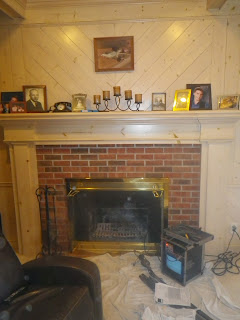The best of the best takes the grand
prize at the Wood Stove Decathlon
Tom Morrissey has been designing and
building soapstone wood-burning stoves since 1978, so when John
Ackerly, Founder and President of the Alliance for Green Heat asked
him to design a new stove a year ago he decided that Woodstock
Soapstone Company was up to the challenge. He assembled his design
team members Jason Guimaraes, Lorin Day, Harold Garabedian, Larry
Young, Ken Blum, Lewis Thibodeau, Dan Batchelder and Kristie Haupt
and got to work on a brand new stove to enter in the November 2013
Wood Stove Decathlon, which was held in Washington, D.C. This week.
The new Ideal Steel Hybrid stove is
something completely new to the company, who has specialized in
soapstone products for 35 years. The new stove is, however, lined
with soapstone bricks in order to take advantage of the stone's
heat-retention and long heat-release properties.
What makes this design so different
from other wood stoves on the market are several factors. The design
team incorporated a secondary air chamber and a catalytic combustor,
while most manufacturers do only one or the other. Then the team
added a tertiary air supply so as the stove gets hotter more air is
fed directly to the catalytic combustor so it does not get oxygen
deprived. This allows the combustor to work more effectively, while
bringing emission levels down even further. The team also found that
a fan is not necessary for the combustion air supply, and the passive
system works very well.
Tom said “We are essentially making a
gasification stove,” he said, “If you look at this thing when
it’s burning, the fire does not look like what you would think of
as a wood fire. The whole top of firebox is like an inverted gas
burner; there are 120 holes with a tube of flame coming out of each
one.”
Instead, they
will employ a remote Woodstove Monitor. It will provide real-time
feedback on burn rate, BTU output, efficiency, emissions, and stove
temperatures.
“Burning wood
without this information is like driving a car without a speedometer
and gas gauge,” said Morrissey. Knowing this information will help
stove owners use their stoves more responsibly and effectively. “Ten
years ago, you could never imagine having a little computer on the
stove. If you were in a small industry like ours, you couldn’t
dream of having a graphic-user- interface, but now it’s available
and affordable,” Morrissey said. The Union
Hybrid stove, with its twenty-first century technology and
efficiency and emissions capabilities, is certainly a far cry from a
six-sided box with a fire in it.
Testing in the lab and at the design
challenge resulted in only 1.03 grams in emissions. That is
extremely low, especially compared to older model stoves. The firebox
size is 3.2 cu ft. emissions are an adjusted level of 1.04 grams.
One of the highlights of the Ideal
Steel Hybrid stove is the custom work. Woodstock Soapstone has a
water jet cutter that enables the company to customize their stove by
adding medallions on the side, attach a mitten warmer or large
artistic design pieces to the back via slots just above the back
legs, custom cut the andirons, and add a custom-cut cook top. These
elements can be changed out easily when the customer wishes to change
the look of the stove.
And if that isn't enough, an optional
LED lamp on a swing arm, powered by heat from the stove is available.
If the power goes out the owner would have not only provide heat,
but a place to cook on three burners at different heights and
temperature variations, and lighting for cooking or reading.
The stove should be available by June
of 2014 and it is factory-direct to the consumer only. Woodstock
does not have dealers.
The Wood Stove Challenge was open to
any company, university, or individual from any country except for
accredited woos stove labs. The grand prize winner received a
$25,000 cash prize which was donated to two teams who did not have
funding. The two second place prizes went to Travis Industries and
Wittus, who shared a $10,000 cash pot.
Sharing third place were
Inter-Continental, Tile Stove and HWAM. Fourth place went to
Tulikivi; fifth went to Intensi-Fire and Mulciber; sixth to Walker
Stoves, Seventh to Smart Stove, and eighth place was awarded to
Kimberly.
The goal of the Challenge was to get
design team's creative juices flowing and make higher efficiency,
affordable wood-burning stoves that produce little emissions. The
expert judging panel with representatives from different agencies and
organizations scored each stove on innovation, market appeal and ease
of use, affordability, emissions, and efficiency.
The primary funders of the Wood
Stove Decathlon are NYSERDA, the Osprey Foundation, the District of
Columbia Urban Forestry Administration, the US Forest Service, the
West Penn Power Sustainable Energy
Fund
and the Arbolito Foundation.
Congratulations to Woodstock Soapstone
and the other finalists who scored high marks by the judges. The next
generation of wood stoves is here.













.JPG)








